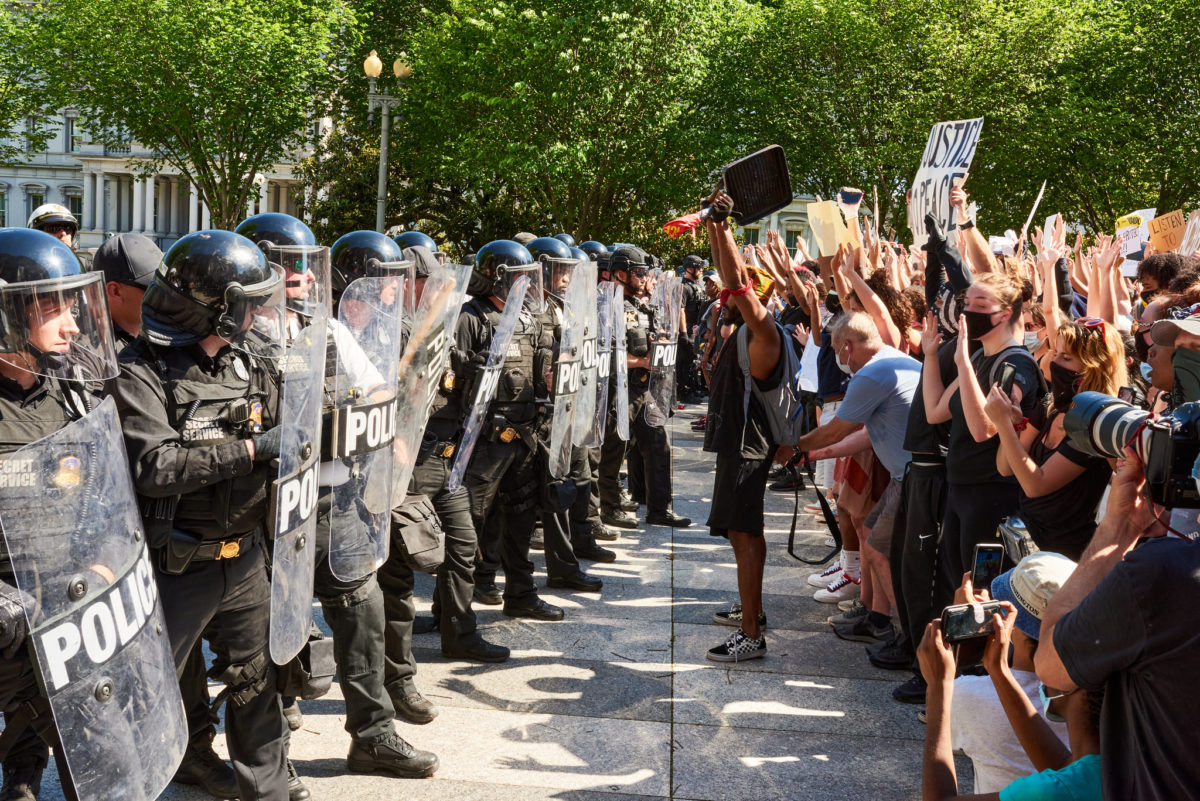When is a protest too dangerous? What are the signs it’s time to go home? How do you know when what you’re hearing is just a rumor — and when it’s an important message that you should listen to?
As street medics, our goal is to spread calm. But at an intense action, rumors — and panic — can spread like wildfire. While it’s good to be aware, and it’s essential to be prepared, that doesn’t mean you need to be afraid — and you definitely don’t need to believe every rumor you hear on the streets.
Want to be more prepared to stay calm, stay safe, and stay in the streets? Here’s how to evaluate rumors, analyze a scene, and practice situational awareness so you can protest safely.
They say: “The cops are about to use tear gas!”
During the months of protests sparked by George Floyd’s death, many protesters experienced tear gas for the first time. Just a year ago, here in Atlanta, the idea of police releasing tear gas seemed almost unthinkable. Now, it often feels like a certainty. For months we were tear gassed every night, and it’s become a weapon the police are far less reluctant to use.
In 2020, we learned to always be prepared to face tear gas every time you go to a protest, no matter how peaceful you expect it to be. However, that doesn’t mean you’re definitely going to get tear gassed — and telling everyone that it’s going to happen will just make everyone more nervous.
How to know when it’s true: If you think logically, this rumor is easy to confirm or deny. Tear gas is an indiscriminate weapon: once they deploy it, it’s just as likely to hit the police themselves as to hit protesters. So you can easily anticipate whether police are about to use it: just check to see if they’ve put their own gas masks on. When the cops put their masks on, you know it’s time to put on yours.
What to do: Apart from the general sense of panic caused when everyone is talking about imminent gas, it can be a disadvantage to put your mask on too soon. When you’re wearing a gas mask, goggles, bulletproof vest, or similar gear that makes you look prepared for a fight, you’re more likely to be targeted. When you look like you’re ready for trouble, the police often assume you’re there to cause trouble. So you can mitigate risk to yourself by keeping your mask and other gear in your bag until it’s needed. Luckily, this is one situation where it’s always obvious when you’re going to need it.
They say: “We’re all going to get arrested!”
Like tear gas, mass arrests (when 50-100 people are all arrested as a group) are a tactic the police hadn’t used in a long time in Atlanta — until they did use it. It’s hard to predict at what point they’ll decide to use it again. However, as a general rule, the city tries to avoid mass arrests, for several reasons.
First, mass arrests are bad press. Arresting a few people to tone down a rowdy protest is one thing; arresting 50 or 100 people who weren’t breaking any laws tends to draw more public criticism. The police don’t care about that, but elected officials do. Most of the time, orders from the top will discourage police from arresting huge numbers of people.
Second, mass arrests are expensive. Most people who are arrested at protests are given very minor charges — the most common is “pedestrian in roadway,” which is a traffic violation. People aren’t normally arrested for traffic violations, because it’s not cost effective for the city to arrest traffic offenders at a large scale. Many of those charges get dismissed, and those that don’t usually only involve small fines. The cost of jailing hundreds of people, even for one night, can cost more than the fines bring in revenue, so most of the time, the city will try to avoid mass arrests unless a protest is extremely disruptive and can’t be contained any other way.
How to know when it’s true: The only way to be certain that a mass arrest will happen is when it’s already happening. It’s very common for many of the signs of a potential mass arrest to be present and for protesters to still be able to disperse without arrest. However, you can look for indications that a mass arrest might be possible or likely.
First, look for a large prisoner transport vehicle such as a bus — or several of them. If you see a few prisoner transport vans and you’re with a group of 100 protesters, then they probably don’t have capacity to arrest all of you (at least not yet). If you see several large buses, then they might be serious about a mass arrest.
Second, look at where the police are gathering in relation to the protesters. If they’re only lining up on one side of the protest, then they probably aren’t planning to arrest all of you — they’re preparing to drive you back. If they’re lining up in front and behind you, there’s still a good chance they’ll let people disperse onto the sidewalk. But if they’re moving in from all four directions, with tightly controlled lines of police shoulder-to-shoulder on all sides, then the chance of a group arrest is much higher.
Finally, look at the equipment they’re carrying. If a couple of cops are pulling out zip ties, that’s normal — but if they’re all pulling out zip ties at once, that’s concerning. Sometimes they’ll use orange netting to block exits on all sides, and if you see them forming lines on all sides with orange netting, that’s a strong indication they’re planning to trap and arrest you.
Police will often give a warning announcement stating that if you don’t move off the street within the next 5 minutes, you will be arrested. Like everything police say, this could be true — but it’s probably not. Most often, it’s an empty threat, and it’s rarely a sign of an imminent mass arrest. Usually a warning will be followed by a few arrests and the hope that fear will disperse the rest of the crowd. Police actions are a much better predictor of a mass arrest than an announcement threatening arrest.
What to do: The key to avoiding arrest is to always know where all the police are — and more importantly, to know where they aren’t. Always be looking for the exits, and don’t get in a position where you’re surrounded.
If you do end up surrounded, remember that making a sudden break for it alone or in a small group will be more likely to make you a target. Think about who’s most vulnerable in your crew, and strategize about how to get them out. Sometimes, if you comply with orders, move to the sidewalk, and calmly walk away from the protest, the police will let you leave. Their goal, after all, is to break up the protest — if you leave, you’re no longer a threat.
If that doesn’t work and you need to get out of the situation, ask a street medic to help you. Sometimes police will let a marked medic leave with an injured person even while they’re kettling for a mass arrest.
When all else fails, write the jail support number on your arm, and don’t panic. The Atlanta Solidarity Fund has been bailing protesters for over ten years and has helped over 800 protesters get out of jail over the summer of 2020. We won’t leave you behind.
They say: “Protesters are under attack!”
Most protests, most of the time, are relatively calm and rarely violent. But attacks can and do happen — from counter-protesters, from police, and sometimes even from fellow protesters. When emotions are high and situations are intense, it’s always possible for fighting to break out.
How to know when it’s true: This is a situation where the question isn’t just whether something is happening, but what exactly is happening. It’s generally smart to be skeptical of rumors — and when the rumors are vague and unclear, you have even more reason to be skeptical. Before you panic about an imminent attack, try to get more details. Who is being attacked, and by whom? How many assailants? Are they armed, and if so, with what? If no one knows any of these details, then you should probably maintain your skepticism until you can get more specific and reliable information. Until you’ve observed a situation firsthand, or heard a detailed and specific report from someone you know well and trust, don’t panic, and avoid repeating unfounded rumors.
What to do: If you’re a street medic, then your first instinct is probably to head toward where the action is! If you decide you want to check it out for yourself, bring your buddy. And unless you can see with your own eyes that the situation is urgent, it’s usually wise to walk, not run. When a marked medic starts running, everyone around them tends to panic. Your job as a street medic is to spread calm, so try to avoid running unless it’s really an emergency.
If you go to see for yourself whether the rumor is true, approach the situation slowly, keeping an eye on all your surroundings so you know what you’re heading into. If you do see an attack happening, take note of specifics and details that will be valuable for others who need to know. Count how many people are involved on each side, and notice what kinds of weapons each side has. Note what the rest of the crowd is doing, and then decide whether you want to get closer or position yourself farther away. You can’t help injured people if you get injured yourself, so don’t feel obligated to rush straight into the fray (unless you want to!) — and make sure you’ve evaluated the full situation first.
Before you go into an intense situation, think about what resources you have and what resources you might want to gather first. For example, if there’s another medic team nearby, you and your buddy can go into the danger zone to get people out and bring them to another medic team at a safer location, who can treat their injuries.
But Should You Be Scared?
When is a protest too dangerous?
When is it time to go home?
Only you can answer that question.
Everyone has a different tolerance for risk, and your ability and desire to face risks can vary widely from one day or even from one hour to the next.
When you’re deciding whether to go or stay, the most important question isn’t what the police are going to do, and it’s not what’s going to happen.
The most important question is: What do you want to do?
Protests are always inherently risky. In some ways, that’s the point.
A protest is meant to be visible. It’s meant to raise awareness. It’s meant to gain attention. Sometimes, it’s meant to be disruptive.
All of these intentions can sometimes involve risk.
For you, the important question isn’t whether a protest is dangerous, but whether the risk is worth it.
The better you get at evaluating situations and analyzing what’s really likely to happen, the better you’ll be at deciding whether the goal of a protest is worth the risk for you.

